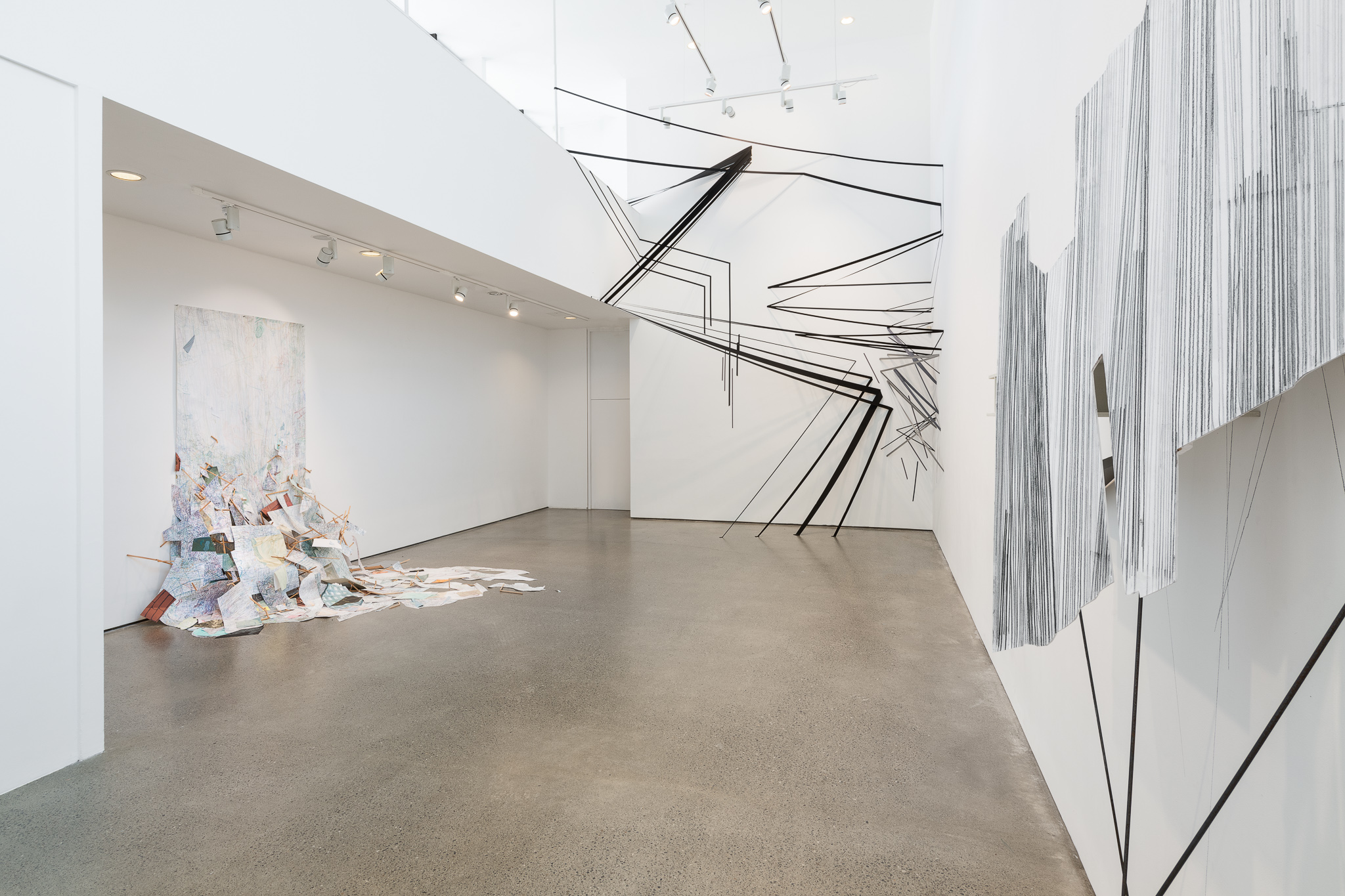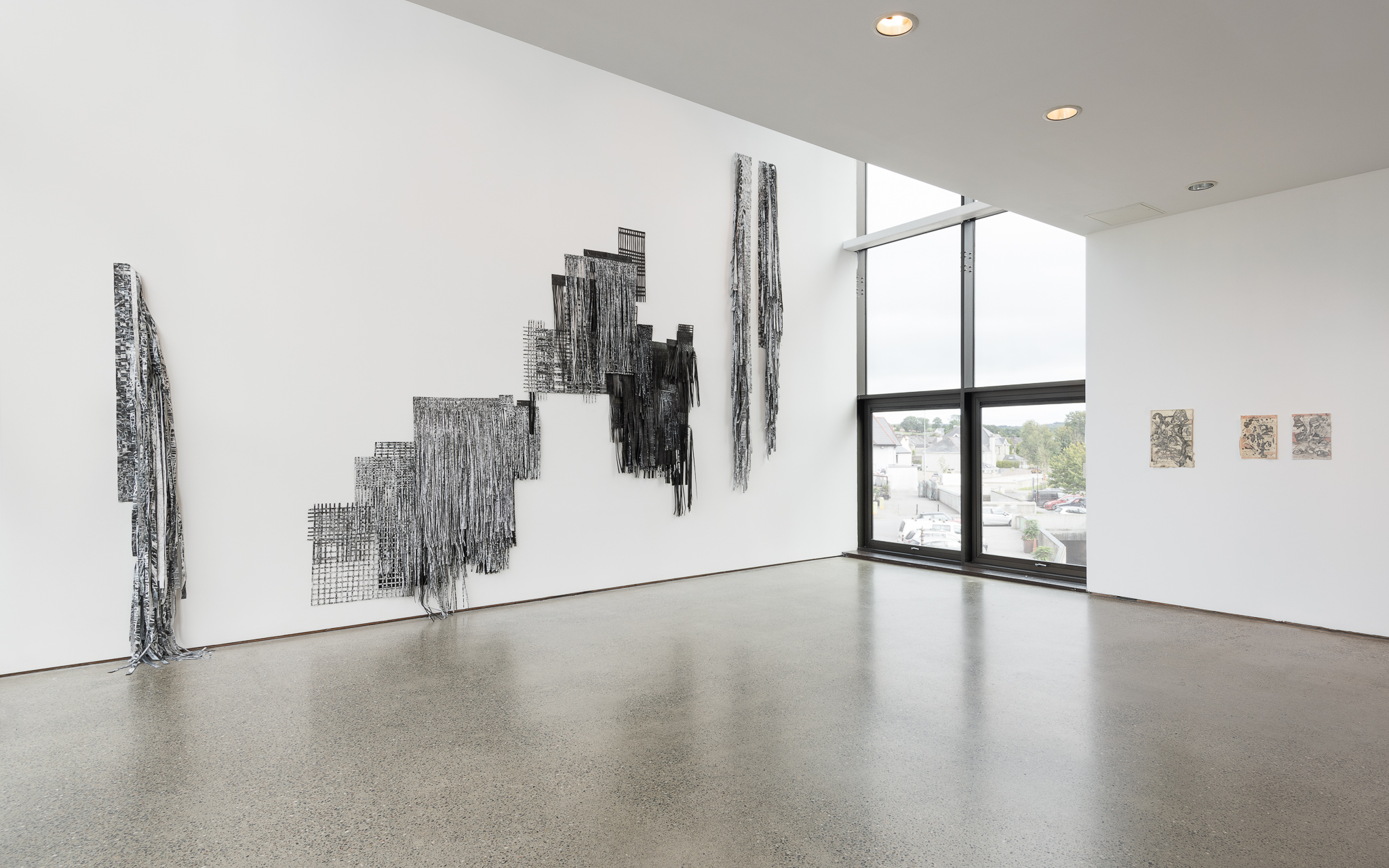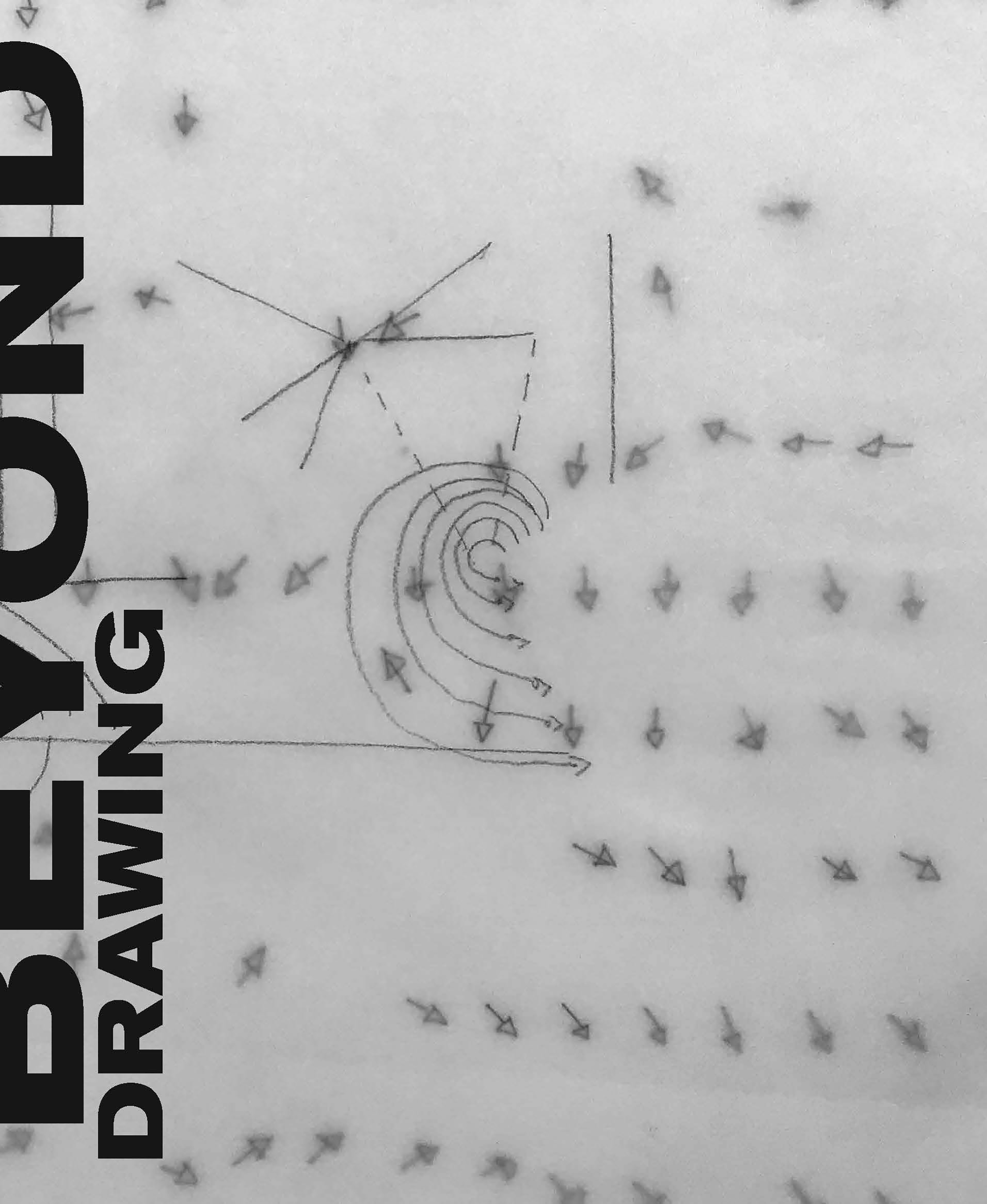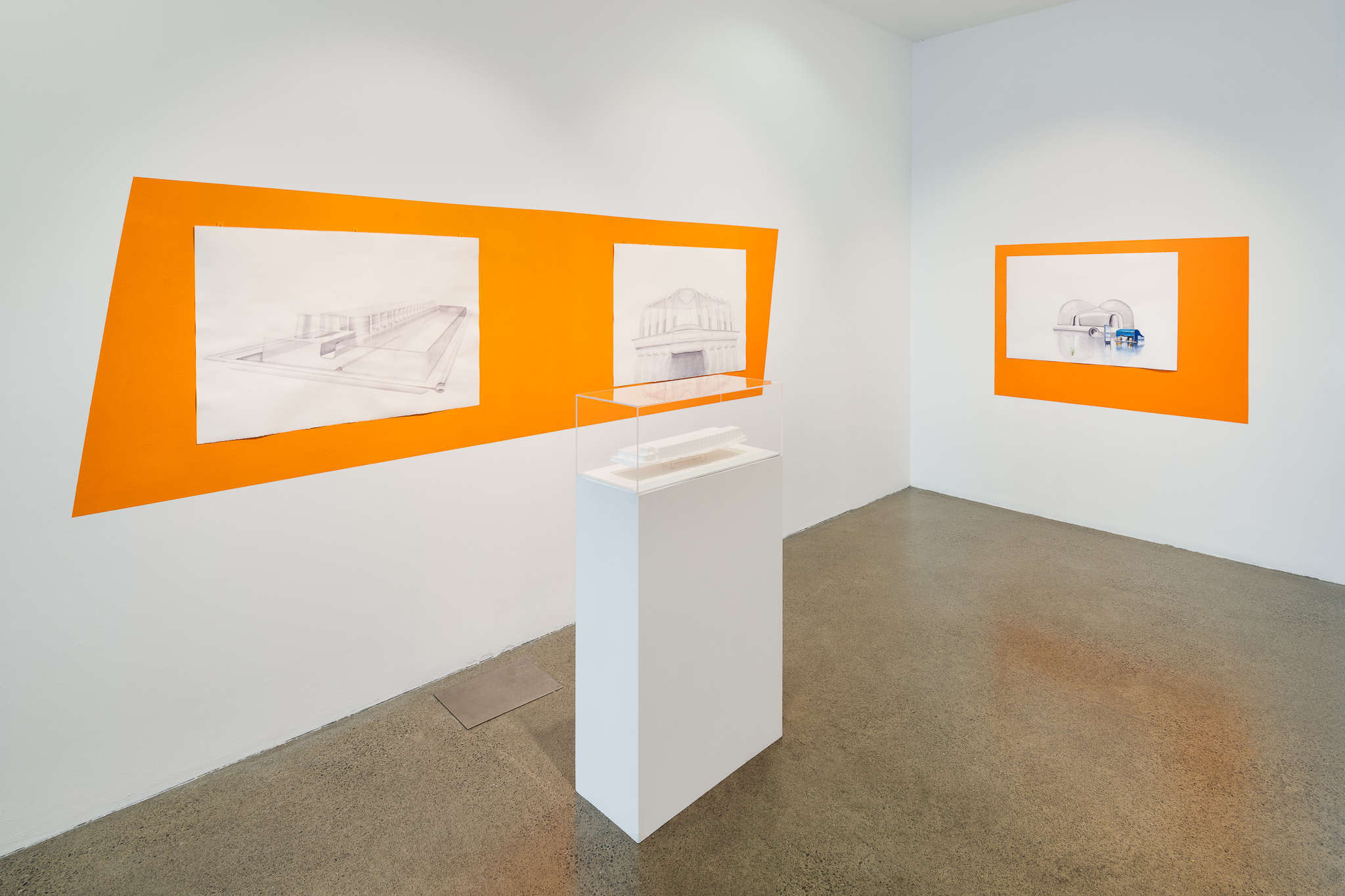Beyond Drawing
 Beyond Drawing
Beyond Drawing
Felicity Clear, Marleen Kappe, Romy Muijrers, Kiera O’Toole, Marisa Rappard, Mary-Ruth Walsh
Curated by Arno Kramer
23 July to 8 September
You can view and download the gallery information pdf by clicking here.
Download and view the Critique from VAN September/October 2022 issue by Mieke Vanmechelen by clicking here.
Opening on Saturday 23 July at 2.00pm with guest speaker Caoimhín Mac Giolla Léith, this group exhibition exploring drawing includes new and site-specific work by three Irish and three Dutch artists curated by Dutch artist and curator Arno Kramer.
Drawing is a speculative and exploratory process, and many contemporary artists are testing what the parameters of a drawing can be. Charcoal, pencil and ink have been supplemented with materials such as wire, tape, wood and steel. Artists are experimenting with materials such as smoke, water, light and air, and methods of presentation such as installation and film.
This exhibition captures a moment in contemporary drawing practices, it invites the viewer to viscerally engage with drawing through an expanded field which opens up new possibilities. Several of the works are site specific and constructed on site over time and in relation to the physical building, all are experimental and explorative, while holding an authenticity and sensitivity to the core of drawing practice.
This approach to drawing lies at the heart of the practice of each artist selected for Beyond Drawing - three artists from Ireland and three from The Netherlands – by curator Arno Kramer.
Based on diagrams of wind speed and direction called hodographs, Felicity Clear’s large scale, site specific Hodograph drawing is made from elastic and paper tape, where light and shadow become part of the spatial drawing to skew perspectives and challenge perception.
In her work, Marleen Kappe explores the borders between drawing and installation presenting partially abstract worlds referring to artificial urban landscapes. Her mixed media work Drifting Fragments comprises architectural elements which start as two-dimensional drawings on the wall and transform into three-dimensional shapes on the floor.
Romy Muijrers drawings are about time, each line drawn or erased in their making becomes part of the work. Then by modelling and bending, she transforms paper into a three-dimensional space, creating a sort of stage set that the viewer can explore.
Kiera O’Toole’s recent weaved drawings comprise hand cut strips of layered graphite, varnish and acrylic on paper, woven into objects which are site specific, in that they attempt to create a ‘holding space’ where the viewer’s awareness of their felt bodily experience in the presence of the drawing unfolds, as the drawing affects the viewer.
Marisa Rappard’s large-scale drawing Body by Proxy, combines abstract and figurative elements, an overlapping montage of shadow figures, silhouettes, body parts and architectural perspectives reflecting the alienating effect of technology and the endless stream of information technology brings.
Mary-Ruth Walsh’s framed and wall-mounted drawings of plastic packaging, accompanied by the corresponding found plastic packaging placed on a shelf or plinth, acquire an architectural quality and highlight the artists’s interest in the relationship between art and architecture, permanence and impermanence.
The exhibition will be accompanied by a series of discussions and other events exploring this expanded field of drawing.

A publication designed by Oonagh Young, featuring an essay by writer and curator Caoimhín Mac Giolla Léith, alongside installation documentation of the works in the galleries at Uillinn, was launched by Brian Fay on 31 July 2023.
You can read the talk on drawing by Brian Fay here. Or watch the video at the end of this page.
From Dublin, Felicity Clear’s practice is drawing based, including drawing installation and animation and involves the intersection of line, light and perception. Drawing in a variety of mediums and in various scales is at the core, from small two-dimensional works on paper to large sculptural installations and hand drawn animation. The provisional nature of drawing and its other technical role in engineering, architecture and everyday life are central reference points. Perspective is often skewed, and three-dimensional elements cast shadows which present visual conundrums. As Francis Halsall says in Drawing the line, Irish Arts Review, Autumn, 2019: ‘Given the priority that Clear gives to line, the work is often suggestive of the aesthetic forms of infrastructure, alluding as they do to maps, plans, scaffoldings and support structures. Through these allusions to infrastructure, her meticulous and intricate constructions become highly effective metaphors for the systems that are ubiquitous in everyday life’.
http://www.felicityclear.com/
In her work, Dutch artist Marleen Kappe explores the borders between drawing and installation. She deals with the structures and strictures of our modern world and is fascinated by the tendency of humankind to create habitats, which have become more and more artificial. Her drawings and installations are partially abstracted worlds referring to artificial urban landscapes which are familiar, yet are too abstracted and emotionally distant to feel comfortable. Architectural elements expand in two and three-dimensions, lines made out of tubes and u-profiles spread out over the floors and wander into the space. Grid structures start as two-dimensional drawings on the wall and transform into three-dimensional parts. Straight lines and precisely drawn machine-like objects are combined with more abstract shapes in a tableau, a frozen moment before movement, filled with tension.
http://www.marleenkappe.nl
Dutch artist Romy Muijrers says ‘Drawing is the most pure and direct way in which I can express personal thoughts and feelings, giving meaning and form to existence by a visual language that has its roots in desire, longing and alienation. I consider my paper to be a score, a composition of abstract and figurative forms which merge or collide. These constructions represent a sense of mental disbalance, a loss of something or someone and are the physical depiction of attraction and repulsion and the longing for being together. An important basis for my work is music, literature and poetry. Sometimes clearly visible in the texts I use, sometimes hidden but always, like waves, present in the background.’
https://www.romymuijrers.nl/
Kiera O'Toole is an Irish artist and practice-based doctoral researcher at Loughborough University, UK. She says ‘Drawing on the phenomenological and aesthetic concept of atmospheric perception, I explore how drawing can map, record, materialise and afford atmospheric experiences. The concept of atmospheres does not refer to meteorology or the atmospheric sciences, rather atmospheres are spatialised feelings which register as some kind of atmospheric charge. I examine how the 'emotional vibrations' of spaces in which we occupy can deeply influence our experience. I consider myself a ‘patheur’; someone who follows their intuitive impulses, and I make drawings that must be felt rather than only intellectually understood. My felt body perceives this charge as an emotive modality of knowing beyond any physical borders. My work attempts to enact a ‘holding space’ for this knowledge that is sensed through our felt bodies and which is in a dialogue with wider forces at play such as social, environmental and cultural contexts’.
https://www.kieraotooleartist.com/
In her drawings, Dutch artist Marisa Rappard investigates what it means to be human in our current, fluid world, in which technology intervenes with lives, contact is ephemeral, and vast amounts of information flows past daily. Drawing with pencil, pen, ink and acrylic, Rappard navigates between abstraction and figuration. The large scale of her work physically makes palpable how it may seem impossible to get a grip on the multitude of facts we are confronted with on a daily basis. To this end Rappard has also constructed spatial drawings, in which she lets the abundancy of lines flow out of the paper and enter the room. The viewer can walk around, or enter these installations, thus being surrounded by an abundance of information that is partly recognizable, yet distorted and elusive. Rappard derives visual elements from cubism and her drawings are often organised around sets of densely cross-hatched lines or repetitions of colourful shapes, which collide abruptly and make for a confusing play with perspective. These elements are associated with a dispersed sense of self, skipping from one online reality into another.
http://www.marisarappard.nl/
 Mary-Ruth Walsh is an Irish artist working in drawing, painting, film-making, sculpture-installation, critical writing and occasionally performance. Her practice explores how architecture affects the way we move and behave. Taking her inspiration from the language of architecture she constructs imagined proposals exploring ideas relating to built space and contemporary culture. Drawing from the utopian ideals of 20th and 21st century architecture and juxtaposing these with vernacular architecture she creates a new dialogue. Often using found objects to make her work, she translates these into architectural shorthand, like a new vocabulary. The theatrical aspect of how the art is displayed both juxtapositions and parallels architecture using seductive surfaces that leads the viewer in. These objects or ‘architectural proposals’ are often placed in undocumented spaces both inside and outside the gallery space. It’s what Walsh calls ‘guerrilla architecture’. These themes are underpinned by rigorous research and the work is not meant to illustrate but rather to engender ideas of why and for who the space is created.
Mary-Ruth Walsh is an Irish artist working in drawing, painting, film-making, sculpture-installation, critical writing and occasionally performance. Her practice explores how architecture affects the way we move and behave. Taking her inspiration from the language of architecture she constructs imagined proposals exploring ideas relating to built space and contemporary culture. Drawing from the utopian ideals of 20th and 21st century architecture and juxtaposing these with vernacular architecture she creates a new dialogue. Often using found objects to make her work, she translates these into architectural shorthand, like a new vocabulary. The theatrical aspect of how the art is displayed both juxtapositions and parallels architecture using seductive surfaces that leads the viewer in. These objects or ‘architectural proposals’ are often placed in undocumented spaces both inside and outside the gallery space. It’s what Walsh calls ‘guerrilla architecture’. These themes are underpinned by rigorous research and the work is not meant to illustrate but rather to engender ideas of why and for who the space is created.
https://www.maryruthwalsh.org/
Arno Kramer works as a visual artist and curator in The Netherlands and in Ireland. In 2015 he was awarded the Netherlands Artists of the Year, in the older artists category. In 2005 he curated Into Drawing: Contemporary Dutch Drawing which travelled to five European countries. In 2009, he curated Into Irish Drawing, travelling in The Netherlands, to France and Northern Ireland. For 20 years, he was a teacher at the AKI Akademie voor Beeldende Kunst en Vormgeving (Academy of the Visual Arts and Design) in Enschede, The Netherlands, and has been a guest lecturer at art colleges in Ireland, England, Scotland and the US. He publishes on the visual arts and also writes poetry. He is currently the first curator of the Drawing Centre Diepenheim in The Netherlands. Recently, he co-curated with Diana Wind, Director of the Stedelijk Museum Schiedam, All About Drawing.100 Dutch Artists, an overview of 50 years of Dutch drawings, presented in the Stedelijk Museum Schiedam.
https://www.arno-kramer.nl/
Caoimhín Mac Giolla Léith is a critic and associate professor in the School of Irish, Celtic Studies and Folklore at University College Dublin. In addition to his writings on literature in the Irish language, both medieval and modern, Caoimhín has published several hundred essays on contemporary art. He is also a contributor to Afterall, Artforum, Frieze, Mousse and Parkett. He has curated exhibitions in Dublin, London, Amsterdam and New York and was a juror for the 2005 Turner Prize. Caoimhín is writing for the publication Beyond Drawing, published by Uillinn: West Cork Arts Centre and available in late 2022.
Images:All photographs by Jed Niezgoda of Beyond Drawing installed in the galleries at Uillinn.
WCAC acknowledges the financial support of Arts Council Ireland and Cork County Council in making these exhibitions possible.



